Jul-15-15
 | | Pawn and Two: The tournament book, "Monte Carlo 1902" by A. J. Gillam, states this game was played March 6th & 7th, 1902. This game was adjourned March 6th, but the tournament book does not indicate on which move the game was adjourned. The tournament book states this game was continued on March 7th, and it lasted for 101 moves, when the game was given up as drawn. The missing moves, from move 57 to move 101, were not provided in the tournament book, but perhaps with additional research, these missing moves may still be found. The tournament book did provide the following diagram, stating that it is from the adjourned position, as given in the Nottingham Guardian. No further information was provided. Therefore, additional research will be needed to try determine whose move it is, or what the move number is in the diagrammed adjourned position. 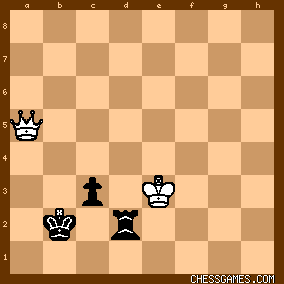
click for larger view |
|
Aug-04-24
 | | KEG: A thrilling endgame to play over--provided you don't consult a computer! Trying hard to win an even endgame, Maroczy got into trouble and was probably theoretically lost after his sloppy 32nd and 35th moves. But Mieses missed his chance with his inexplicable blunder on move 35. The endgame and pawn race that ensued is a blockbuster, provided you don't consult Stockfish, which knows that the game is a draw. Had I been playing Black against Maroczy, I would have been scared to death (unless I was looking at a computer). Mieses obviously didn't have that luxury, so we can enjoy his brave stand and dogged resistance. Overall, Mieses had awful results against the usually accurate Maroczy (about whom a long-overdue biography has now been published). In eighteen games against Maroczy, Mieses managed eight draws but not a single win. At the time this game was played, Maroczy was locked in a tight battle with Pillsbury with three rounds (including this game) to go. Maroczy had a lead of 0.25 points but Pillsbury had an extra game to make up potentially worth half a point. In this 19th round, both Maroczy (this game) and Pillsbury drew their games. But in the replays, Maroczy defeated Mieses while Pillsbury lost both his replay against Marco from this round as well as his replay of his 18th round draw against Tchigorin. When the dust had settles, Maroczy had a lead of 0.75 points. Though Pillsbury won his last two games, Maroczy scored 1.5 points in his last two rounds, winning the tournament by 0.25. What all this means is that had Mieses exploited his advantage and managed to defeat Maroczy in this game, Pillsbury probably would have won this tournament. 1. e3

click for larger viewSome may raise their eyebrows at this move. I suspect that Maroczy, who was one of the very best positional players of this era, felt that the only risk he faced from the tactically-brilliant Mieses was some sort of wild shoot-out. Thus, for much of the game, Maroczy seemed content to play solid unambitious moves, trusting that either Mieses would self-destruct or that they would reach an even endgame, a part of the game in which Maroczy had few peers. I wonder, however, if Maroczy would have followed this strategy had he know the endgame here resulted in a game of 101 moves (only 56 of which are currently available to us). 1... c5?!
Already looking for complications, else Mieses might have tried 1...Nf6 or 1...d5. There are, of course, other strategically good options for Black (e.g., 1...b6 or 1...e5). Mieses' move left: 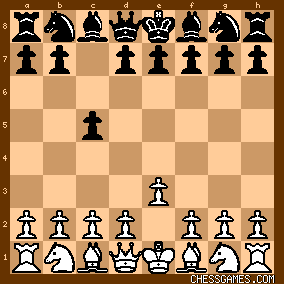
click for larger view2. f4?!
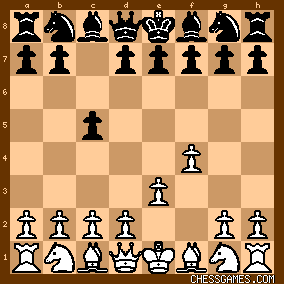
click for larger viewKind of a reverse Dutch Defense. This I guess was an attempt by Maroczy to keep Mieses off kilter and to limit Mieses' tactical opportunities. Ohterwise, I would assume Maroczy would just have played 2. Nf3 or 2. d4 with a solid position and a small but real edge. 2... d5
The first move in this game that I actually correctly predicted. 3. Nf3
Back to "normal" chess.
3... Nc6
The only question was whether Mieses might try to make a play for the a1...h8 diagonal with 3...b6. The text, of course, was completely fine and left the following even but interesting position: 
click for larger view |
|
Aug-05-24
 | | KEG: Post II
4. Bb5
Willing to trade off this Bishop. It is interesting that Maroczy did not chose to go for the long diagonal with 4. b3....yet. 4... Bg4
Looks a bit anti-positional. If he didn't want to commit with 4...e6, Mieses might have tried 4...Bd7 (foiling Maroczy's plan) or just 4...Nf6
The position after the text was:

click for larger view5. h3
Maroczy continues his cautious play rather than pressing for the initiative with 5. c4. This seems to be part of Maroczy's anti-Mieses strategy, which worked well for him over the years (since he never lost a game to the dangerous Mieses). 5... BxN
While not any kind of true "mistake" or blunder, I don't understand why Mieses played into Maroczy's strategy rather than the simple 5...Bd7. 6. BxN+
Any Bishop lover would play 6. QxB here and retain the option of playing to obtain the advantage of the two Bishops. But, as always, it seems that Maroczy knew exactly what he was doing. 6... bxB
7. QxB
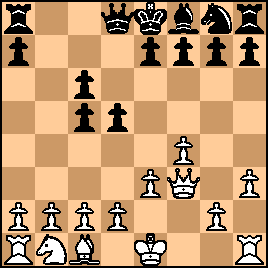
click for larger viewBasically an even position. But I reckon that Maroczy was confident that Mieses would try something rash. He didn't have to wait long: 7... e6
He still had the chance to go for the diagonal with 7...g6. But as will be seen, Mieses was operating on a different wavelength. 8. b3
Not surprisingly, Maroczy decided to seize the long diagonal. And not, Mieses couldn't restrain himself any longer: 8... f5?!
Creating all sorts of weaknesses in the Black camp. But Mieses always seemed anxious to mix it up one way or another. Simplest and theoretically best for Black here is probably 8...Be7 so that if 9. Bb2 he could play 9...Bf6. 
click for larger view9. Bb2
Obviously indicated. Maroczy now had what edge existed in the position. 9... Nf6
10. 0-0
Almost any other top player would likely have tried to punish Mieses with 10. g4. But Maroczy, confident he could defeat Mieses in any quiet positional struggle, was in no hurry. 10... Be7
11. d3
The game had not settled into the sort of maneuvering contest in which Maroczy usually found a way to prevail without taking any chances. This concept almost cost him dearly in this game. The text, of course, is unobjectionable. 11... 0-0
12. Nd2

click for larger view12... Qe8
Apparently lusting to bring the Queen to attack on the King-side. But why? 12...Qc7 or 12...a5 were surely better. But, once again, Mieses' move was no sort of blunder. 13. e4
Slowly playing to try to control the board.
13... fxe4
14. dxe4
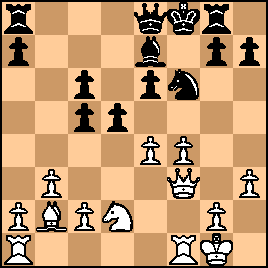
click for larger viewMaroczy was probably satisfied to have emerged from the opening with a small edge and with no tactical risks to confront. But now the play got funky and the game became quite interesting. |
|
| Aug-05-24 | | FM David H. Levin: <KEG: Post II
4. Bb5
Willing to trade off this Bishop. It is interesting that Maroczy did not chose to go for the long diagonal with 4. b3....yet.> This and the next few moves seem to involve a fight for control of the e5-square. I suspect that White played 4. Bb5 so that Black wouldn't have time to prevent the exchange of this bishop for the c6-knight. Black in turn, played 4...Bg4 probably both to eliminate White's e5-controlling knight and to avoid a later problem of how to post his light-square bishop so as to support some strategic plan. |
|
Aug-05-24
 | | perfidious: <KEG....13. e4
Slowly playing to try to control the board.
13... fxe4
14. dxe4
Maroczy was probably satisfied to have emerged from the opening with a small edge and with no tactical risks to confront. But now the play got funky and the game became quite interesting....> My preference would have been for the more thematic 13.Qf2, intending Nf3 and an eventual c2-c4 to play against the doubled pawn complex, in line with this Nimzo-Larsen type of position. |
|
| Aug-06-24 | | FM David H. Levin: <KEG: Post II> The diagram after 8...f5 is missing a pawn at g7. |
|
Aug-06-24
 | | KEG: <David H. Levin>Oops. Thanks for spotting my careless typo. I think you have identified the rational for 4. Bb5 and the following moves, but I'm not a big fan of this approach here. Given his prior play, 4. b3 looks more logical. But, for whatever it's worth, Fritz seems to be with you on this and is happy with 4. Bb5. But this might have worked poorly for Maroczy had Mieses played 4...Nf6 or 4...e6. At this stage, however, I doubt there is anything close to right or wrong. Mainly a question of style. |
|
Aug-06-24
 | | KEG: <perfidious> I very much like your thinking with regard to 13. Qf2 rather than 13. e4. Among other things, Maroczy could still have followed with 14. e4 as well as with your idea of c4. My only qualm about all this is that, with regard to such positional considerations, I am always hesitant to second-guess Maroczy. For what it's worth, if Maroczy were here today to read your comment, I suspect he would have seen substantial merit in your concept. |
|
Aug-07-24
 | | perfidious: <KEG>, those were the fledgling days of this system. Nimzowitsch, of course, was the player who got this line out of the blocks; two games I learnt from as a young master were: A Nimzowitsch vs H Wolf, 1923 and
A Nimzowitsch vs Saemisch, 1929 |
|
Aug-07-24
 | | KEG: <oerfidious> Thank you for the references. I will have to examine these games. This is not an opening line with which I have any real experience. |
|
Aug-07-24
 | | KEG: Post III
14... Nh5
As usual, Mieses shunned something safe such as 14...Qg6 and sought complications or--depending on Marocy's reply--simplification (as quickly occurred). 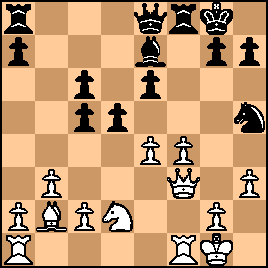
click for larger view15. Qg4
As was typical of his style as this time, Maroczy did not try to hold his small middlegame edge but was willing to entertain an endgame. Other than Lasker (who was pretty much idle from 1900 until 1904) and Pillsbury at that time, Maroczy was the finest endgame player when this game was played. He probably expected to win any even endgame with any sort of imbalances. 15... Qg6
Having said "A," Mieses decided he had to play "B." 16. Be5
I am surprised that Maroczy didn't just play 16. QxQ to mess up Mieses' King-side. Even with that, however, he would only have enjoyed a small endgame advantage. 16... QxQ
Too late for Mieses to back down now, even though, by reducing to an endgame, he was entering Maroczy's lair. 17. hxQ Nf6
18. BxN
In turn, Maroczy, having allowed the trade of Queens, pretty much had to trade off his Bishop: 
click for larger view18... RxB
Weak. With the much stronger 18...BxB, Mieses would either have gained a tempo or forced 19. e5. But if this was the sort of small error on which Maroczy was counting in courting the endgame, he missed an opportunity here: 19. e5
Giving Mieses what he wanted. Better would have been wither 19. Rae1 supporting his pawn mass, or 19. g5 immediately. After the text, Mieses' position was looking far healthier than might have been expected against his dangerous endgame opponents. In fairness to Maroczy, however, this game was played at the end of a long an exhausting tournament: 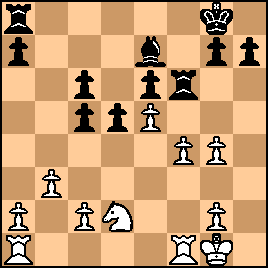
click for larger view19... Rf7?
Missing an excellent chance for counter-play and some initiative with 19...Rg6. But even after the second-best text, Mieses was no longer in any real trouble. And he did, for one thing, have a potentially strong Bishop against Maroczy's Knight. 20. g3
Typically careful, slow, and precise endgame play by Maroczy (already preparing for Mieses' next move). 20... Raf8

click for larger viewMaroczy had made a career from his ability to win such approximately even but unbalanced endgame. The first step, as was so often the case, was to gobble up space: 21. g5!

click for larger viewFor all the interesting imbalances on the board, it would have been hard to foresee the kind of titanic struggle (another 80 moves!) that lay ahead. |
|
Aug-07-24
 | | perfidious: <KEG>, as an aside, if you have never come across a copy, Keene's <Nimzowitsch: A Reappraisal> is a classic. |
|
Aug-07-24
 | | KEG: <perfidious> I have not read that book but, on your recommendation, I will now order it. |
|
Aug-07-24
 | | KEG: Post IV
21... g6
This looks awful. I would rather play 21...h5?! than give White this target on the h-file. I cannot, however, fathom why Stockfish thinks White is now close to winning with 22. Nf3. In any case, we never got to find out what would have transpired after 22. Nf3 since Maroczy here played: 22. Kg2
I get it. Maroczy was preparing to play 23. Rh1. But this was too transparent since Mieses was sure to play: 22... h6
Either this or 22...would have foiled Maroczy's concept. 23. gxh6
Maroczy had no choice. The text left:
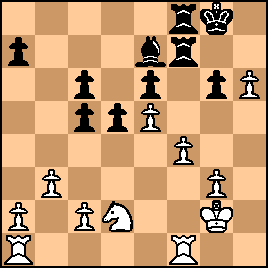
click for larger view23... g5!
Now equalizing exchanges were sure to follow and the crisis for Mieses appeared to have passed: 24. fxg5 Bxg5
25. RxR RxR
26. Nf3 Bxh6

click for larger view27. Rh1
Indicated, but not longer much of a threat, especially with White's two isolated pawns. 27... Kg7

click for larger viewThe best chance now for White to make something out of nothing seems to lie in 28. g4. But here Maroczy came up with a valiant plan: attack on the a-file! Theoretically it is hopeless, but Maroczy was apparently--trusting in his endgame abilities--willing to take significant chances based on his seeming confidence that he could outplay Mieses even if he got himself into trouble (which he did). 28. Rh4
With all the time in the world (and computer assistance) it is clear to me that Maroczy's plan was flawed. Had I been sitting across the board from Maroczy, however, I would have been terrified. In any case, Maroczy's move itself was no serious error. It was his plan that was problematic. 28... Kg6
The King is a fighting piece in the endgame. But here 28...Be3 immediately was better. The text gave Maroczy an opportunity to shift plans: 
click for larger viewWith the clock ticking and the move-30 time control looming, it must have been difficult for Maroczy to switch gears He should have played 29. Kf2 to stop 29...Be3. One possible line would then have been 29...Rg7 30. Ne1 c4 31. bxc4 Bg5 32. Rd4 c5 33. Rd3 dxc4 34. Rc3 Bd2 35. Rxc4 BxN+ 36. KxB Kf5 37. Rxc5 Rxg3 38. Ra5 Rg7 with a pawn-plus Rook and pawn ending for White that is probably a theoretical draw but that might go otherwise in practice. But Maroczy was probably too far down the rabbit hole to change course: 29. Ra4 Be3

click for larger viewMaroczy had not yet crossed the Rubicon, but did so on his next move (move 30!) and then doubled-down on it on his 32nd turn. The computers don't like Maroczy's ensuing play one bit, but it led to the thrilling and often wild endgame scramble that followed. |
|
Aug-08-24
 | | KEG: Post V
30. Ra6?!
With something like 30. g4 or 30. Nh4+, Maroczy would have been fine. But he was playing to win and was willing to take some risks. He was fighting with Pillsbury for first place and could not have known that Pillsbury was going to lose his upcoming replays against Tchigorin and Marco. 30... Kf5!
Superb endgame aggression by Mieses. Unless he exploited the misplacement of Maroczy's Rook immediately, he could easily have gotten into difficulties. This all left:

click for larger view31. Rxc6
Too late to back down now!
31... Ke4
Meanwhile, Mieses' King was becoming a beast:

click for larger view32. Nh2?
Huh?
Maroczy was now under pressure, but he would not have been in terrible shape with 32. Ne1. Alternatively, if he wanted to continue to press Mieses, he might have tried the slightly riskier 32. Nh4. Maroczy was presumably aiming for Ng4 and Nf6. But this was all too slow, and he was leaving his Queen-side undefended and allowing the Black d-pawn to become a wrecking force. At this point, I am not sure that Maroczy could have saved the game with best play by both sides. 32... Rf2+
Ouch!

click for larger view33. Kh3
Forced.
33... Rxc2
34. Rxe6

click for larger viewThis position was the high point of the game for Mieses. Maroczy's Queen-side was about to get decimated, and the Black d-pawn would soon roll. But now we see the impatience of Mieses on which Maroczy may have been relying come to the fore. He could possibly have won here with the terribly obvious 34...Rxa2. One possible line from there would have been 35. Ng4 [everything else seems hopeless] d4 36. Rf6 [36. Re8 does not look much better] Bg5 [or maybe better still 36...Re2 37. e6 Bg5 38. Rf7 a5 39. Nh2 Kd3 after which Maroczy would have been hard pressed to stay alive] 37. Rf7 a5 38. Nf2+ Kxe5 39. Nd3+ Kd6 40. Ra7 Kd6 again with winning chances for Black. Instead, however, Mieses tried to go immediately for the jugular with: 34... d4?!
Maroczy took immediate advantage with:
35. Ng4!
The idea behind the otherwise misguided 32. Nh2. But it remained unclear whether Maroczy even now could hold the game: 
click for larger view |
|
Aug-08-24
 | | KEG: Post VI
Incredible to relate, Mieses here again missed a likely win by again failing to play Rxa2. Instead, now fixated on his d-pawn, Mieses played: 35... d3?

click for larger viewFrom here, Maroczy displayed his endgame accuracy and the game became a theoretical draw. What follows in this game becomes dreadfully boring if Stockfish is consulted [0.00] but absolutely breath-taking if our silicone friends are set aside. 36. NxB
Forced
36... KxN
37. Rd6
Forced

click for larger view37... Rxa2
Too late!
38. e6!
Forced.
38... Re2
Forced.

click for larger viewAt this point when first playing over the game, I kept changing my mind about how the game should end. Pawn races in the end-game can indeed be thrilling, and this game was no exception. 39. Kg4
39. g4 was also good.
39... Kd2
40. Kf5
Forced!
40... Kc2

click for larger viewI might here have commented "What a finish!" But that seems crazy given that the game was to last another 61 moves! Meanwhile, Maroczy had to stay on his toes to avoid being steamrolled: 41. g4!
Forced. With the Black d-pawn poised to advance, Maroczy needed more than just his e-pawn in action to have any chance to survive. 42... d2

click for larger view43. g5!
Forced but very strong. Now Mieses also had to watch his back. 43... Kxb3
When I first played over the game, this looked like a massive blunder to me. By contrast, Black seems to draw easily with either 43...Rf2+ or 43...Re3. Meanwhile, Stockfish still says 0.00 and seems bored to tears. Another reason not to want to be a computer or a robot. 44. g6

click for larger viewTo a human, this sure looks gruesome for Black. After all, White will be able to Queen one of his pawns and his Rook can sacrifice itself to take care of the Black d=pawn. As will be seen, however, even without perfect play, Black can draw here with Rook and two pawns versus Queen. But stay tuned! |
|
Aug-09-24
 | | KEG: Correction:
I mis-numbered the moves after 41. g4. The correct score through Maroczy's 43rd move was: 41. g4 d2
42. g5 Kxb3
43. g6
The position I displayed in my last post shows the board after 43. g6 My next post will pick up in the last diagrammed position after 43. g6. So sorry for the misnumbering typos. |
|
Aug-09-24
 | | KEG: Post VII
43... Rf2+
Obviously forced since 44. g7 would otherwise be decisive. 44. Kg5 Rg2+
Forced!
45. Kf6 Rf2+
Again, forced.
46. Kg7

click for larger view46... Re2
Yet another forced move for Mieses.
47. Kf7 Rf2+
Here too, Mieses' move was forced.
48. Ke8 Rg2
Still walking a tightrope of forced moves.
49. e7

click for larger view49... Rxg6!
Yet another forced move. If instead 49...Kc2 White wins after 50. Kf7. 50. Rd3+
Of course not 50. RxR d1(Q).
The text left:
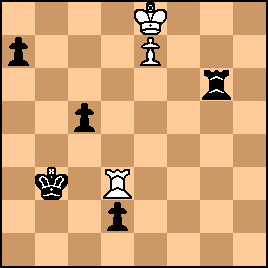
click for larger view50... Kc2?
As it turns out, this doesn't lose, but it condemned Mieses to another exhausting 50 moves of torture. A simpler way to draw (since here White does not Queen a pawn) was 50...Kc4! 51. Rxd2 Re6 52. Kf7 Rxe7+ 53. KxR Kb3 and draws. 51. Rxd2+ !
Obviously forced.
51... KxR
52. Kf7

click for larger viewNow Black cannot stop the White e-pawn from Queening, but--curiously--the game is still a theoretical draw. 52... Rg3
53. e8(Q) c4
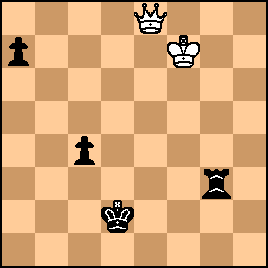
click for larger viewEven if White picks up the Black a-pawn--which Maroczy eventually did--White has no legitimate way to win: 54. Qd8+ Rd3
55. Qg5+ Kc2
56. Qg2+ Kb3

click for larger viewThe remaining 45 moves have been lost. We know that Maroczy played on trying to win and ultimately won the Black a-pawn, but all to no avail. The game was later adjourned in the following position: 
click for larger viewI do not know whether this was the final position. In any case, the result after much hard work was a draw at move 101. |
|
|
|
|





